











|

The summer of 1976 was filled with excitement for planetary scientists as the Viking landers touched down upon the surface of the red planet. The Viking landers were the first completely successful spacecrafts to land on Mars. Previous to this time the USSR had made several attempts of landing on the planet. The Mars 2 soft lander crashed on the surface. The Mars 3 soft lander made the first successful landing, but only transmitted 20 seconds of data before it failed. The Mars 6 lander returned some atmospheric descent data, but failed during the descent. The Mars 7 lander missed the planet entirely.
Before Viking arrived at Mars, landing sites were chosen for both Viking landers, but after examining orbiter photographs, new sites were chosen. Safety of the landers was a high priority to the Viking site certification team. Locations such as Olympus Mons and Valles Marineris, although interesting, were much too dangerous. On July 20, 1976 Viking lander 1 arrived at its chosen site in the western part of Chryse Planitia at 47.8° north latitude and 22.5° west longitude. From orbit this site appeared as a smooth, sparsely cratered plain somewhat like a lunar mare with occasional wrinkled ridges. On August 7, 1976, Viking lander 2 touched down on Utopia Planitia 48° north latitude and 225.6° west longitude.
Each of the Viking landers carried a series of science packages which included a weather station, a seismometer, a chemical analysis package, two cameras, a soil composition package, and a biological experiment package. Within minutes of lander 1's touch down, the first picture was taken in case something happened to the spacecraft. This picture showed what looked like a sandy, dusty surface with rocks up to 10 cm in diameter. The two cameras on each lander were mounted on opposite sides of the space craft. This allowed stereoscopic images to be taken which could be used to calculate distances from the lander to the features in the pictures.
Without prior knowledge, the terrain at the landing sites could be mistaken for some of Earth's rocky deserts. Lander 1 pictures showed a gently rolling landscape that is a yellow-brown in color with rocks of all sizes strewn through out the scene. The rocks have rough surfaces and are pitted from wind carried particles. Drifts of fine-grained debris can also be seen in the pictures. During the Viking 1 winter, a thin layer of water frost formed on the ground for approximately 100 days out of the year.
The lander 2 site also looks like a rocky desert on Earth; however, it is rocker than at the lander 1 site and is less hilly. There are no drifts of sand close to the lander; however, several channels measuring as large as a meter in width and up to 10 cm deep, meanders through the pictures. The smoothness of the soil suggests that the rocks sit upon a layer of hard packed sediment. One of the most apparent differences from that of an Earth desert scene is the Martian sky which appears pink in color due to the reddish dust in the atmosphere. Without the dust the sky would appear almost black because of the thinness of the Martian atmosphere.
| Viking Lander Surface Photographs |
|---|
 Monster Viking Lander 2 Mosaic -- Geometrically Corrected
Monster Viking Lander 2 Mosaic -- Geometrically Corrected
This monster mosaic of Utopia Planitia was created from more than 20 of the
highest resolution images taken by Viking Lander 2. A few holes containing
the viking lander were filled by lower resolution images. This image is
geometrically corrected to take into account an 8° slope of
Viking Lander 2.
The Viking Lander 2 site looks like a rocky desert on Earth. It
is rocker than at the lander 1 site and is less hilly. There are
no drifts of sand close to the lander; however, several channels
measuring as large as a meter in width and up to 10 cm deep, meanders
through the pictures. The smoothness of the soil suggests that the
rocks sit upon a layer of hard packed sediment.
(Copyright 1997 Calvin J. Hamilton)
 Monster Viking Lander 2 Mosaic
Monster Viking Lander 2 Mosaic
This image is the same as the above image except that it has not been
geometrically corrected.
One of the footpads of Viking Lander 2 is on a rock which creates
about a 8° slope for the camera. The apparent looking hill in the
center of the image is due to the slope of the camera. The terrain
is in reality flat.
(Copyright 1997 Calvin J. Hamilton)
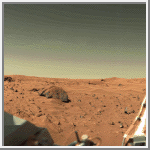 Lander 1 Site
Lander 1 Site
Big Joe, the large rock just left of center is about 2 meters (7 feet)
wide. The top of the rock is covered with red soil. The exposed portions of
the rock are similar in color to basaltic rocks on Earth. This rock may
be a fragment of a lava flow that was later ejected by an impact crater.
The red color of the rocks and soil is due to oxidized iron in the
eroded material. In some areas of this scene rocky plains tend to
dominate, while a short distance away drifts of
regolith have formed.
(Courtesy NASA/JPL)
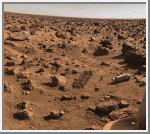 Lander 2 Site
Lander 2 Site
Viking Lander 2 used its sampler arm to
dig these two trenches in the regolith.
The shroud that protected the soil collector head during the lander's
descent lies a short distance away. The lander's footpad is visible in
the lower right corner of the image. The rounded rock in the center
foreground is about 20 centimeters (8 inches) wide, while the angular
rock farther back and to the right is about 1.5 meters (5 feet) across.
The gently sloping troughs between the artificial trenches and the angular
rock, which cut from the middle left to the lower right corner, are
natural surface features.
(Courtesy NASA/JPL)
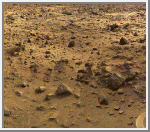 View From Lander 1
View From Lander 1
The Viking Lander 1 site in Chryse Planitia is a barren desert with
rocks strewn between sand dunes. The lander's footpad is visible at
lower right; a trench in the foreground (just below center) was dug by the
sampler arm. Patches of drift material and possibly bedrock are
visible farther from the Lander.
(Courtesy NASA/JPL)
 View From Lander 2
View From Lander 2
The Viking Lander 2 site in Utopia Planitia has more and larger blocks
of stone than does the Viking Lander 1 site in Chryse Planitia. The
stones are probably ejecta
from impact craters near the Lander 2 site.
Many of the rocks are angular and are thought to be only slightly altered
by the action of wind and other forms of erosion. Drifts of sand and dust
are smaller and less noticeable at the Lander 2 site. The overall red
coloring of the Martian terrain is due to the presence of oxidized iron
in the regolith. The pink color of the sky is caused by extremely fine
red dust that is suspended in Mars' thin atmosphere.
(Courtesy NASA/JPL)
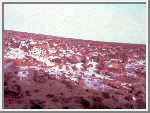 Frost at the Viking 2 Lander
Frost at the Viking 2 Lander
Viking Lander 2 is far enough north that frost deposits form on the
surface during winter. This image, taken in May 1979, shows a thin,
white layer of water frost, estimated to be only microns thick,
covering parts of the surface. The reddish regions are soil and rock
not covered by the frost. Portions of the spacecraft are visible in the
right foreground.
(Courtesy NASA/LPI)

Viking Lander 1
This is a color composite of Viking Lander images 12d089.red, 12d088.grn, and
12d087.blu.
(Copyright Calvin J. Hamilton)
 Viking Lander 1
Viking Lander 1
This is a color composite of Viking Lander images 12f010.red, 12f010.grn, and
12f010.blu.
(Copyright Calvin J. Hamilton)
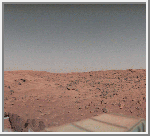 Viking Lander 1
Viking Lander 1
This is a color composite of Viking Lander images 12h051.red, 12h051.grn, and
12h051.blu.
(Copyright Calvin J. Hamilton)
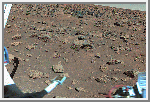 Viking Lander 2
Viking Lander 2
This is a color composite of Viking Lander images 21a082.red, 21a082.grn, and
21a082.blu.
(Copyright Calvin J. Hamilton)
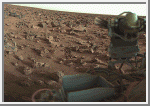 Viking Lander 2
Viking Lander 2
This is a color composite of Viking Lander images 21d049.red, 21d049.grn, and
21d049.blu.
(Copyright Calvin J. Hamilton)